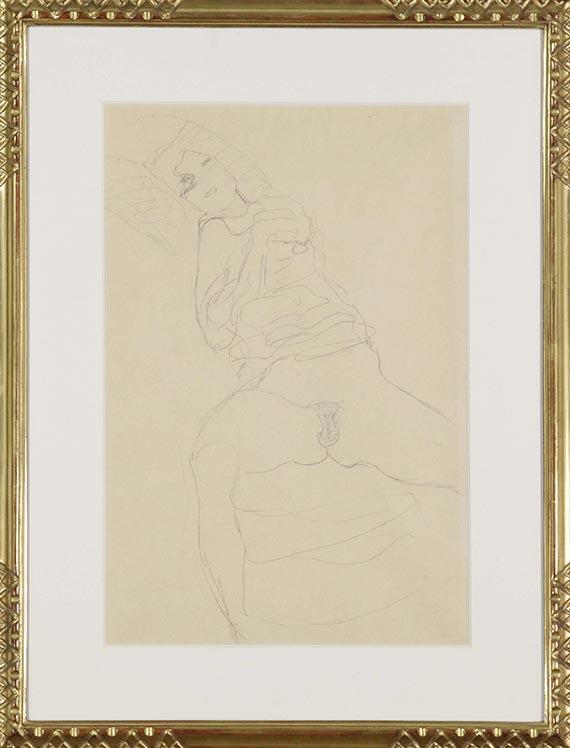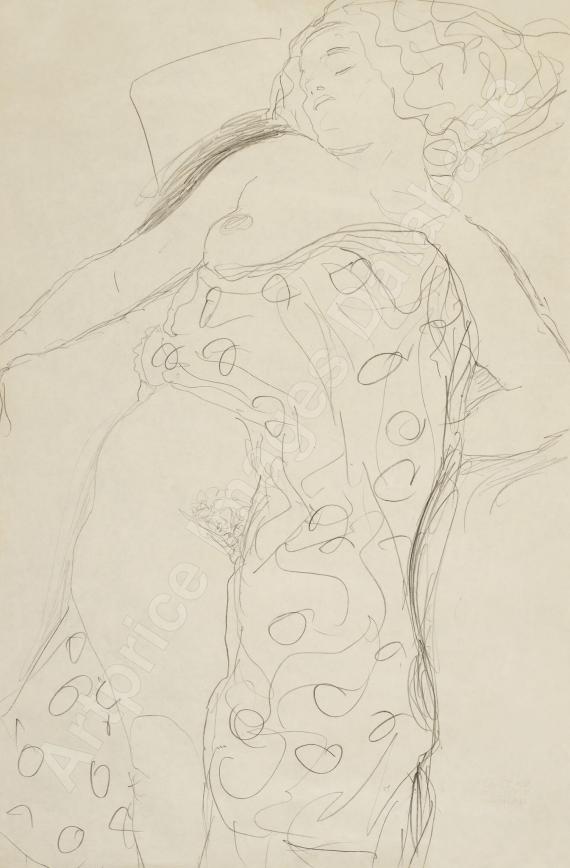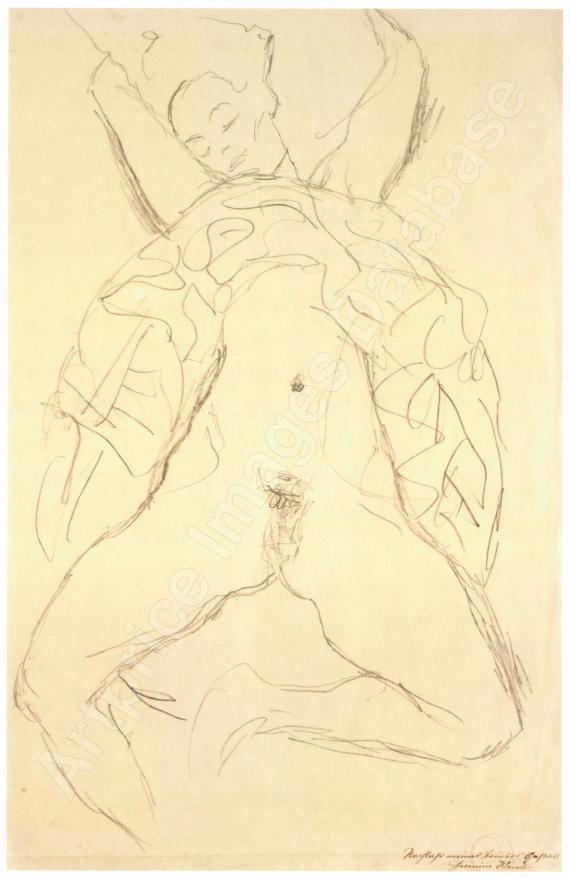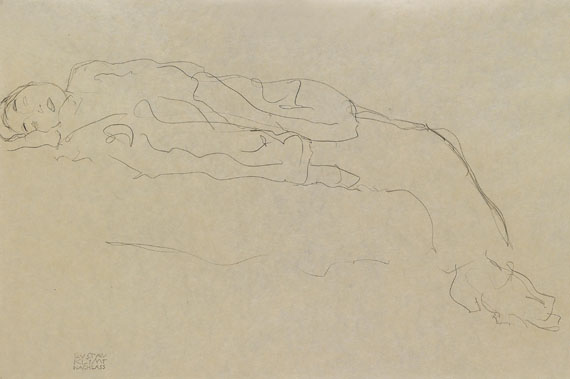Frame image
209
Gustav Klimt
Halbakt von vorne, nach links liegend, 1917/18.
Pencil drawing
Estimate:
€ 60,000 - 80,000
$ 66,000 - 88,000
Halbakt von vorne, nach links liegend. 1917/18.
Pencil drawing.
Strobl 3058. With a barely legible estate stamp to the lower right (faded, Lugt 1575 ). On off-white Japon. 56.3 x 37.2 cm (22.1 x 14.6 in), size of sheet. [CH].
• Study for the right figure in the monumental painting "Die Braut" (Belvedere Vienna).
• "Die Braut" is one of the most expressive key works by the artist, who died in 1918.
• Document of the mutual inspiration between Gustav Klimt and his former student Egon Schiele (1890-1918)
• Other preliminary drawings for "Die Braut" are in the collections of, among others, the Metropolitan Museum of Art, New York, the National Gallery of Art in Washington, D. C. and the Albertina in Vienna.
The work will be included into the online catalogue raisonné of Gustav Klimt's drawings, compiled by Dr. Elisabeth Dutz, Albertina, Vienna.
PROVENANCE: From the artist's estate (with the estate stamp in lower right).
Galerie Nagel, Vienna.
Serge Sabarsky Collection (1912-1996), New York.
Serge Sabarsky Estate, New York (1996).
Vally Sabarsky Collection (1909-2002), New York.
Vally Sabarsky Foundation, New York.
LITERATURE: Alice Strobl, Gustav Klimt. Die Zeichnungen, vol. III (1912-1918), Salzburg 1984, cat. no. 3058, pp. 228f. (with illu.).
Called up: December 7, 2024 - ca. 14.32 h +/- 20 min.
Pencil drawing.
Strobl 3058. With a barely legible estate stamp to the lower right (faded, Lugt 1575 ). On off-white Japon. 56.3 x 37.2 cm (22.1 x 14.6 in), size of sheet. [CH].
• Study for the right figure in the monumental painting "Die Braut" (Belvedere Vienna).
• "Die Braut" is one of the most expressive key works by the artist, who died in 1918.
• Document of the mutual inspiration between Gustav Klimt and his former student Egon Schiele (1890-1918)
• Other preliminary drawings for "Die Braut" are in the collections of, among others, the Metropolitan Museum of Art, New York, the National Gallery of Art in Washington, D. C. and the Albertina in Vienna.
The work will be included into the online catalogue raisonné of Gustav Klimt's drawings, compiled by Dr. Elisabeth Dutz, Albertina, Vienna.
PROVENANCE: From the artist's estate (with the estate stamp in lower right).
Galerie Nagel, Vienna.
Serge Sabarsky Collection (1912-1996), New York.
Serge Sabarsky Estate, New York (1996).
Vally Sabarsky Collection (1909-2002), New York.
Vally Sabarsky Foundation, New York.
LITERATURE: Alice Strobl, Gustav Klimt. Die Zeichnungen, vol. III (1912-1918), Salzburg 1984, cat. no. 3058, pp. 228f. (with illu.).
Called up: December 7, 2024 - ca. 14.32 h +/- 20 min.
Gustav Klimt's painting “Die Braut" (The Bride), one of the most expressive main works in his oeuvre, remained unfinished as his last symbolist composition after his sudden death in 1918 (today at the Unteres Belvedere, Vienna). His sketchbooks and his graphic legacy testify to a comprehensive, meticulous occupation with the motifs and the individual female figures in the painting. The present sheet here can be linked to the female nude in the right of the painting, to which Klimt, unlike in the unfinished painting, added a buckled garment that covers the breast. The figure can be seen as a repetition of the bride, the main figure in the center of the painting, and is often read as the bride's erotic dream. In fact, Klimt does not portray a specific model here, but creates a universal image, the personification of the feminine.
For his erotic prints Klimt also found inspiration in, among others, Japanese woodcuts. At the same time, the drawing is evidence of the mutual inspiration between Klimt and his former student Egon Schiele (1890-1918). In his later creative years, Klimt was inspired by Schiele's art from between 1910 and 1914, while the latter dealt with Klimt's works from 1916/17. Schiele's influence can also be clearly seen in the drawing offered here: the provocative pose of the female nude, the elongated torso, the fragmentary limbs and even the outlines formed from many short, curved and sometimes juxtaposed lines are reminiscent of the younger artist's works. Nevertheless, they also show the elementary characteristics of his very own, particularly creative artistic work and also his extraordinary artistic development in the field of drawing in later years. The rhythmic execution of the interior drawing, the moving contour lines and the invariably curved, lively forms and lines evoke a kind of momentum of movement, the pose of the sitter appears less rigid and more relaxed. Klimt succeeds in depicting the human figure without an exterior source of light, that is to model without shading, entirely from within and from the free line. The drawings from this late creative phase testify to the completion of his mastery in graphic art and occupy an important position within his entire artistic work of these years - also in connection with his painterly works. [CH]
For his erotic prints Klimt also found inspiration in, among others, Japanese woodcuts. At the same time, the drawing is evidence of the mutual inspiration between Klimt and his former student Egon Schiele (1890-1918). In his later creative years, Klimt was inspired by Schiele's art from between 1910 and 1914, while the latter dealt with Klimt's works from 1916/17. Schiele's influence can also be clearly seen in the drawing offered here: the provocative pose of the female nude, the elongated torso, the fragmentary limbs and even the outlines formed from many short, curved and sometimes juxtaposed lines are reminiscent of the younger artist's works. Nevertheless, they also show the elementary characteristics of his very own, particularly creative artistic work and also his extraordinary artistic development in the field of drawing in later years. The rhythmic execution of the interior drawing, the moving contour lines and the invariably curved, lively forms and lines evoke a kind of momentum of movement, the pose of the sitter appears less rigid and more relaxed. Klimt succeeds in depicting the human figure without an exterior source of light, that is to model without shading, entirely from within and from the free line. The drawings from this late creative phase testify to the completion of his mastery in graphic art and occupy an important position within his entire artistic work of these years - also in connection with his painterly works. [CH]
209
Gustav Klimt
Halbakt von vorne, nach links liegend, 1917/18.
Pencil drawing
Estimate:
€ 60,000 - 80,000
$ 66,000 - 88,000
Buyer's premium and taxation for Gustav Klimt "Halbakt von vorne, nach links liegend"
This lot can be subjected to differential taxation plus a 7% import tax levy (saving approx. 5 % compared to regular taxation) or regular taxation.
Differential taxation:
Hammer price up to 800,000 €: herefrom 32 % premium.
The share of the hammer price exceeding 800,000 € is subject to a premium of 27 % and is added to the premium of the share of the hammer price up to 800,000 €.
The share of the hammer price exceeding 4,000,000 € is subject to a premium of 22 % and is added to the premium of the share of the hammer price up to 4,000,000 €.
The buyer's premium contains VAT, however, it is not shown.
Regular taxation:
Hammer price up to 800,000 €: herefrom 27 % premium.
The share of the hammer price exceeding 800,000 € is subject to a premium of 21% and is added to the premium of the share of the hammer price up to 800,000 €.
The share of the hammer price exceeding 4,000,000 € is subject to a premium of 15% and is added to the premium of the share of the hammer price up to 4,000,000 €.
The statutory VAT of currently 19 % is levied to the sum of hammer price and premium. As an exception, the reduced VAT of 7 % is added for printed books.
We kindly ask you to notify us before invoicing if you wish to be subject to regular taxation.
Differential taxation:
Hammer price up to 800,000 €: herefrom 32 % premium.
The share of the hammer price exceeding 800,000 € is subject to a premium of 27 % and is added to the premium of the share of the hammer price up to 800,000 €.
The share of the hammer price exceeding 4,000,000 € is subject to a premium of 22 % and is added to the premium of the share of the hammer price up to 4,000,000 €.
The buyer's premium contains VAT, however, it is not shown.
Regular taxation:
Hammer price up to 800,000 €: herefrom 27 % premium.
The share of the hammer price exceeding 800,000 € is subject to a premium of 21% and is added to the premium of the share of the hammer price up to 800,000 €.
The share of the hammer price exceeding 4,000,000 € is subject to a premium of 15% and is added to the premium of the share of the hammer price up to 4,000,000 €.
The statutory VAT of currently 19 % is levied to the sum of hammer price and premium. As an exception, the reduced VAT of 7 % is added for printed books.
We kindly ask you to notify us before invoicing if you wish to be subject to regular taxation.




 Lot 209
Lot 209 



